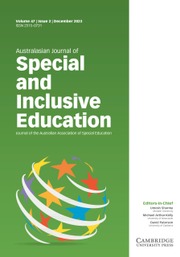Article contents
Screencast-Delivered Professional Development Targeting Teachers’ Self-Efficacy and Beginning-of-the-Year Classroom Management Practices
Published online by Cambridge University Press: 30 March 2020
Abstract
Classroom management remains one of the greatest challenges for teachers. In this study, with 52 general and special education teachers, we examined the effectiveness of a screencast-delivered professional development program focused on classroom management practices in the first 3 days of school. Results suggest that after participating in the program, teachers report a positive change to the start of their school year across 12 different areas. Further, teachers’ classroom management self-efficacy increased significantly after completing the program, and there was a significant correlation (r = .41) between increases in classroom management self-efficacy and rate of implementation of new practices. Implications for practitioners and future directions for research are included.
Keywords
- Type
- Original Articles
- Information
- Australasian Journal of Special and Inclusive Education , Volume 44 , Issue 1 , July 2020 , pp. 60 - 72
- Copyright
- © The Author(s) 2020
Footnotes
This manuscript was accepted under the Editorship of Michael Arthur-Kelly.
References
- 2
- Cited by


